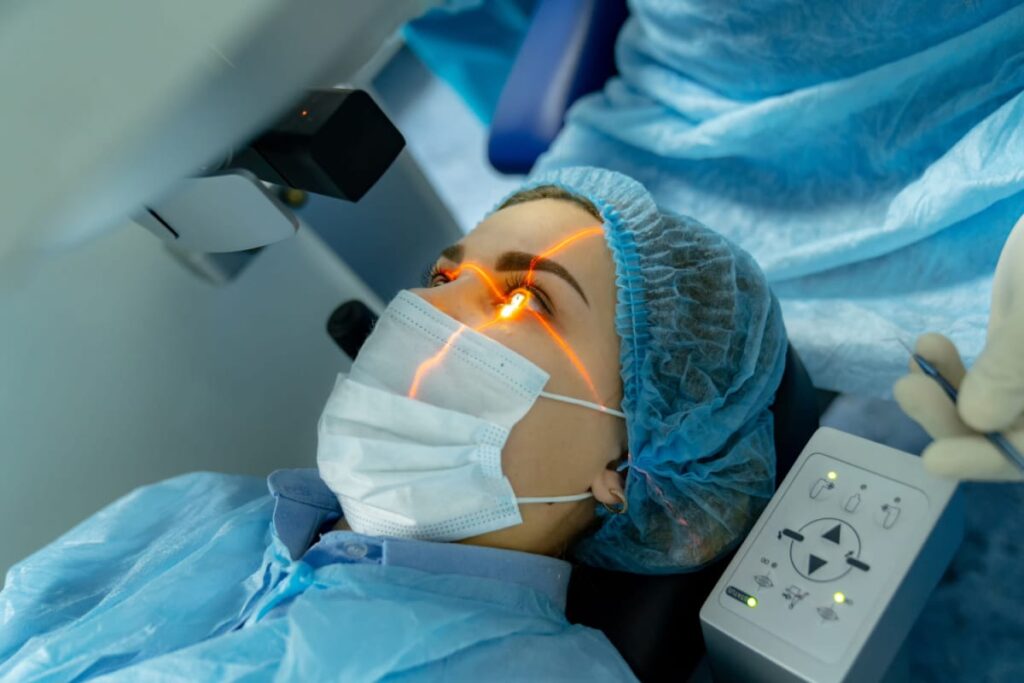Lens replacement surgery, also known as refractive lens exchange (RLE), has become an increasingly popular option for individuals seeking to improve their vision. As with any medical procedure, understanding the costs involved is crucial for making informed decisions. This article delves into the costs associated with lens replacement surgery in Australia and compares them to other common eye procedures.
Understanding Lens Replacement Surgery
Lens replacement surgery involves the removal of the eye’s natural lens and its replacement with an artificial intraocular lens (IOL). This procedure is particularly beneficial for individuals suffering from cataracts or presbyopia, allowing them to regain clear vision without the need for glasses or contact lenses. The surgery is usually performed on an outpatient basis, meaning patients can return home the same day, which adds to its appeal for those seeking a quick resolution to their vision problems.
In summary, lens replacement surgery is a viable option for individuals seeking to improve their vision, with costs in Australia typically ranging from AUD 3,000 to AUD 7,000 per eye. While this may seem steep compared to other procedures like cataract surgery and LASIK, it is essential to consider the long-term benefits and potential savings on eyewear.
Benefits of Lens Replacement Surgery
One of the primary advantages of lens replacement surgery is the potential for improved quality of life. Many patients report enhanced clarity of vision and reduced dependence on corrective eyewear. Furthermore, the procedure is typically quick, often completed within an hour, and boasts a high success rate. Patients may also benefit from advancements in technology, such as premium IOLs that can correct astigmatism or provide multifocal vision, allowing for a more tailored approach to individual vision needs. This means that not only can patients enjoy clearer vision, but they may also find themselves able to engage in activities they once found challenging, such as reading fine print or driving at night.
Potential Risks and Considerations
As with any surgical procedure, lens replacement surgery carries risks. Complications can include infection, inflammation, or issues with the placement of the IOL. It is essential for patients to discuss these risks with their ophthalmologist to ensure they have a comprehensive understanding before proceeding. Additionally, patients should be aware that the recovery process can vary; while many experience immediate improvements in vision, others may take a few weeks to fully adjust to their new lenses. Regular follow-up appointments are crucial during this period to monitor healing and address any concerns that may arise, ensuring that the best possible outcomes are achieved.
Cost of Lens Replacement Surgery in Australia
The cost of lens replacement surgery in Australia can vary significantly based on several factors, including the type of IOL chosen, the surgeon’s experience, and the specific clinic or hospital. On average, patients can expect to pay between AUD 3,000 and AUD 7,000 per eye.
Factors Influencing Cost
Several elements can influence the overall cost of lens replacement surgery. The choice between monofocal, multifocal, or toric lenses can lead to differing price points. Monofocal lenses, which correct vision at one distance, are generally the most affordable option. In contrast, multifocal lenses, which provide clear vision at multiple distances, tend to be more expensive due to their advanced technology. Read more about technology at https://aimseducation.edu/blog/the-impact-of-technology-on-healthcare
Additionally, the reputation and experience of the surgeon can impact costs. Highly regarded specialists may charge more for their expertise, but this can often translate to better outcomes. Finally, the location of the clinic can also play a role; urban centres may have higher prices compared to regional areas.
Out-of-Pocket Expenses
It is essential for patients to consider out-of-pocket expenses when budgeting for lens replacement surgery. While private health insurance may cover part of the costs, many policies do not fully cover the procedure, especially if it is deemed elective. Patients should check with their insurance provider to understand their coverage and any potential gaps in funding.
Moreover, patients should also factor in the costs associated with pre-operative assessments and post-operative care. Pre-operative consultations, which may include comprehensive eye examinations and discussions about the best lens options, can add to the overall expense. After the surgery, follow-up appointments are crucial to monitor healing and ensure the lenses are functioning correctly, which may incur additional fees. Understanding these potential costs is vital for patients to avoid any unexpected financial burdens during their treatment journey.
Furthermore, it is advisable for patients to explore financing options that clinics may offer. Many facilities provide payment plans or financing solutions that allow patients to spread the cost over time, making the procedure more accessible. This can be particularly beneficial for those who may not have immediate access to the full amount required. By researching and discussing these options with their healthcare provider, patients can make informed decisions that align with their financial situation while prioritising their eye health.

Comparing Lens Replacement Surgery to Other Eye Procedures
To provide a clearer perspective on the costs associated with lens replacement surgery, it is beneficial to compare it to other common eye procedures, such as cataract surgery and LASIK. Each of these procedures has its unique advantages and considerations, as well as varying costs.
Cataract Surgery Costs
Cataract surgery is often performed when the natural lens of the eye becomes cloudy, impairing vision. The cost of cataract surgery in Australia typically ranges from AUD 2,500 to AUD 5,000 per eye. Similar to lens replacement surgery, the final price can vary based on the type of lens used and the surgeon’s experience.
Patients should note that cataract surgery is often covered by Medicare, which can significantly reduce out-of-pocket expenses. However, if patients opt for premium lenses or choose a private hospital, additional costs may arise. Furthermore, the recovery time for cataract surgery is generally swift, with many patients experiencing improved vision within a few days. This rapid recovery can be particularly appealing for those eager to return to their daily activities, such as reading or driving, without prolonged disruption.
LASIK Surgery Costs
LASIK (Laser-Assisted In Situ Keratomileusis) is a popular refractive surgery aimed at correcting vision issues such as myopia, hyperopia, and astigmatism. The cost of LASIK surgery in Australia generally ranges from AUD 2,000 to AUD 4,000 per eye. This procedure involves reshaping the cornea using laser technology, allowing light to focus correctly on the retina.
While LASIK can provide excellent results, it is essential to consider that it may not be suitable for everyone, particularly those with certain eye conditions or thin corneas. Additionally, unlike lens replacement surgery, LASIK does not involve the removal of the natural lens, which may be a deciding factor for some patients. It’s also worth noting that LASIK is often viewed as a long-term solution, with many patients enjoying clear vision for years, but some may require enhancement procedures later on. This potential for additional costs should be factored into the overall financial considerations when weighing the options for vision correction. Click here to find more about natural.
Long-Term Financial Considerations
When evaluating the costs of lens replacement surgery compared to other procedures, it is crucial to consider the long-term financial implications. Lens replacement surgery may have a higher initial cost, but it can potentially eliminate the need for glasses or contact lenses, leading to savings over time.
Cost of Eyewear
For individuals who rely on glasses or contact lenses, the cumulative cost of purchasing eyewear can be substantial. High-quality glasses can range from AUD 200 to AUD 800, while contact lenses can cost between AUD 300 to AUD 600 annually. Over several years, these expenses can add up, making lens replacement surgery a more financially viable option in the long run. Furthermore, the costs associated with eyewear do not merely include the purchase price; they also encompass regular eye examinations and potential updates to prescriptions, which can further inflate the overall expenditure on vision correction.
Impact on Lifestyle
Beyond the financial aspect, lens replacement surgery can significantly enhance a person’s lifestyle. Improved vision can lead to greater independence, allowing individuals to engage in activities they may have previously avoided due to poor eyesight. This can include driving, participating in sports, or simply enjoying daily life without the hassle of corrective eyewear. Moreover, the psychological benefits should not be overlooked; many patients report increased confidence and a renewed sense of freedom after undergoing the procedure. The ability to wake up in the morning and see clearly without the need for glasses or contacts can transform daily routines, making mundane tasks more enjoyable and less cumbersome.
Additionally, lens replacement surgery can also contribute to better overall health. Clear vision is essential for maintaining an active lifestyle, which in turn can lead to improved physical health. Individuals who can see well are more likely to engage in outdoor activities, exercise regularly, and maintain social connections, all of which are vital for mental and emotional well-being. In this way, the benefits of lens replacement surgery extend far beyond mere vision correction, fostering a more vibrant and fulfilling life.
Conclusion
Ultimately, making an informed decision requires thorough research and discussions with qualified professionals. Patients should weigh the costs against the potential benefits and consider their unique circumstances before proceeding with any eye surgery.
Investing in one’s vision is an investment in quality of life. By understanding the costs and implications of lens replacement surgery compared to other procedures, individuals can make choices that best suit their needs and lifestyles.
Read more at: Breaking Down the Laser Eye Surgery Price Is It a Good Investment

